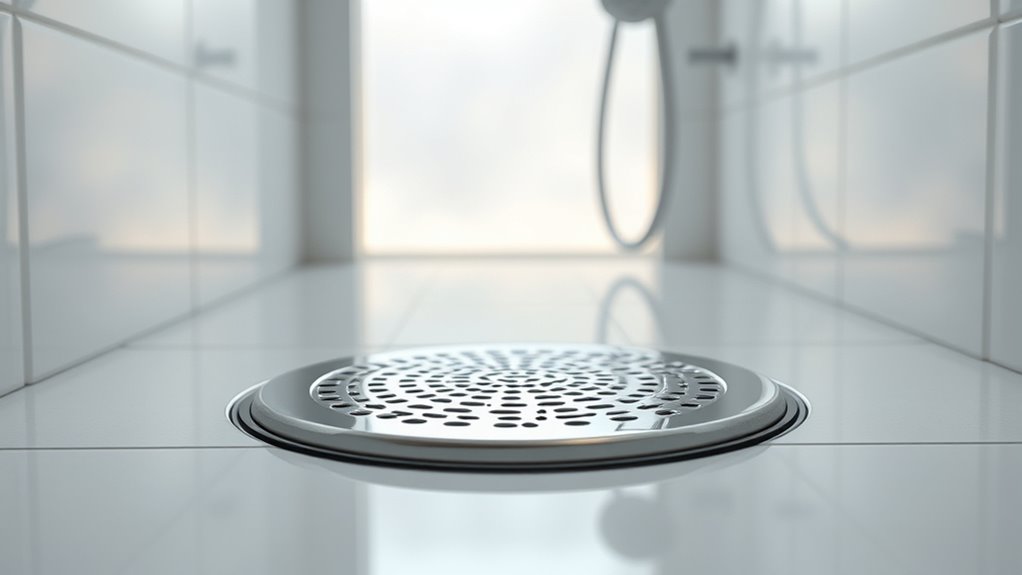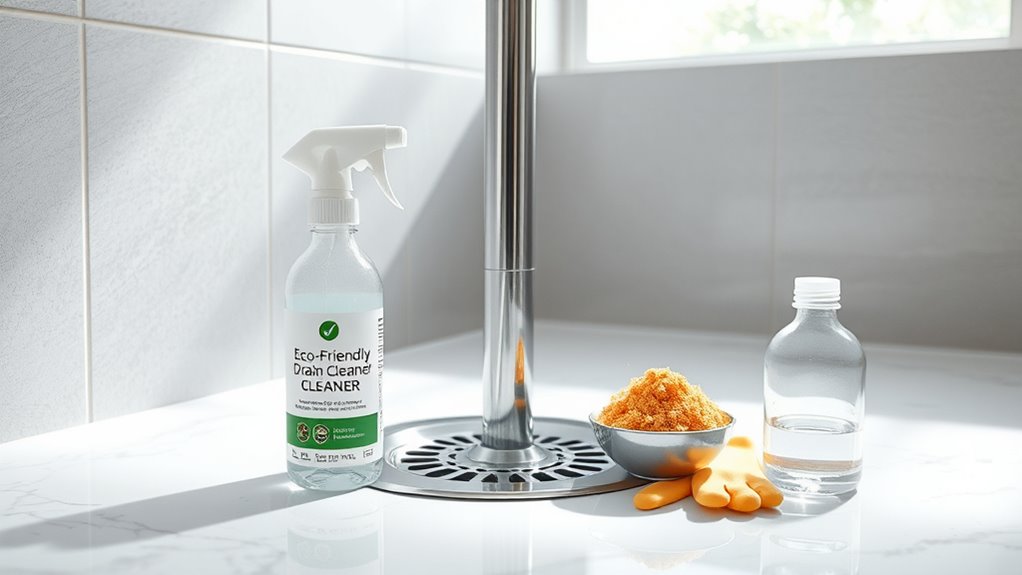How to Clean a Shower Drain Pipe and Prevent Clogs: Easy DIY Steps
Cleaning a shower drain pipe is essential for preventing clogs and ensuring smooth water flow. Start by removing the drain cover. Use a flexible drain snake to tackle deep clogs and a sponge or cloth for surface cleaning. Regularly flush the drain with hot water, and try the baking soda and vinegar technique for buildup. Schedule monthly maintenance to keep drains clear. There are additional tips and methods tailored for effective results that can aid in maintaining clean drains.
Understanding the Importance of a Clean Shower Drain

A clean shower drain is essential for maintaining a functional bathroom environment. It plays a significant role in the overall hygiene and efficiency of the plumbing system.
A well-maintained drain prevents unpleasant odors and minimizes the risk of water backing up during showers, which can be both inconvenient and unsanitary. Regular cleaning of the shower drain helps to eliminate bacteria, mold, and mildew that thrive in damp environments.
Furthermore, a clean drain allows for proper wastewater flow, reducing the likelihood of future clogs. Homeowners who prioritize drain maintenance can extend the lifespan of their plumbing system while ensuring a more pleasant bathing experience.
To conclude, understanding the importance of a clean shower drain is critical for both health and functionality in any bathroom.
Common Causes of Shower Drain Clogs
Shower drain clogs often arise from two primary issues: hair buildup and soap scum accumulation.
Hair can easily become trapped in the drain, creating a barrier that impedes water flow.
Meanwhile, soap scum can coat the interior of the pipes, further contributing to blockages over time.
Hair Buildup Issues
Hair buildup frequently plagues homeowners, often leading to frustrating clogs in shower drain pipes. This issue arises mainly from the natural shedding of hair during showers, which accumulates over time.
Long strands are particularly problematic, as they can intertwine and create dense masses that obstruct water flow. Additionally, the use of hair products may contribute to the stickiness of the buildup, further exacerbating the clogging issue.
Drain covers can help mitigate this problem by trapping loose hair before it enters the plumbing system. Regularly removing visible hair from the drain and utilizing these preventive measures can greatly reduce the likelihood of severe clogs, ensuring smoother water drainage and less stress for homeowners.
Soap Scum Accumulation
Clogs in shower drain pipes can also result from soap scum accumulation, which occurs when soap residue mixes with water and minerals.
This sticky substance adheres to the walls of pipes, gradually reducing their diameter and impeding water flow. Soap scum is particularly prevalent in areas with hard water, where mineral content is high.
Over time, this buildup can trap hair and other debris, further exacerbating clogs. Regular cleaning of the shower area and the drain can help minimize soap scum formation.
Homeowners may consider using vinegar or baking soda as natural solutions for breaking down soap scum.
Tools You’ll Need for Cleaning
To effectively clean a shower drain pipe, certain tools are essential for the task.
Gathering the right cleaning instruments and safety equipment can make the process smoother and safer.
This section will outline the necessary items needed to tackle the cleaning job efficiently.
Essential Cleaning Tools
Cleaning a shower drain pipe effectively requires a few essential tools that can make the task easier and more efficient.
A flexible drain snake is vital for reaching deep clogs, while a pair of pliers can help remove the drain cover and manage stubborn debris. A bucket is necessary for collecting water and any unwanted materials that may spill during cleaning.
Additionally, a sponge or cloth will aid in wiping down surfaces, ensuring no residue remains. A long-handled brush can reach into tight spaces, effectively removing buildup.
Finally, a funnel or measuring cup is helpful for pouring cleaning solutions into the drain accurately. These tools streamline the cleaning process, ensuring thorough maintenance of the shower drain pipe.
Safety Equipment Needed
A variety of safety equipment is vital when tackling the task of cleaning a shower drain pipe. First, gloves are essential to protect the hands from sharp objects, chemicals, and bacteria found in the drain.
Safety goggles should also be worn to shield the eyes from splashes and debris. A mask or respirator can help prevent inhalation of dust or harmful particles, particularly when using chemical cleaners.
Additionally, knee pads may provide comfort and protection when working on the floor. It is also advisable to have a bucket nearby to collect waste and excess water, minimizing mess and potential slips.
Safety Precautions Before You Start
Before undertaking the task of cleaning a shower drain pipe, it is essential to prioritize safety. Ensuring a safe working environment reduces the risk of accidents and injuries. Proper preparation can make the cleaning process smoother and more efficient.
- Wear gloves: Protect hands from sharp objects and harmful substances that may be present in the drain.
- Use goggles: Shield eyes from debris and potential splashes while working with cleaning solutions or tools.
- Ensure ventilation: Maintain airflow in the bathroom by opening windows or using a fan, especially if using chemical cleaners.
How to Remove the Drain Cover
With safety measures in place, the next step involves removing the drain cover to access the shower drain pipe.
First, one should determine the type of drain cover, as they can vary between screw-in and snap-on designs. For screw-in covers, a screwdriver is necessary; the individual must carefully unscrew each fastener, ensuring not to strip the screws.
In contrast, snap-on covers can be lifted off gently, using a flathead screwdriver to pry it up if needed. It is essential to avoid applying excessive force to prevent damage.
Once removed, the drain cover can be set aside for cleaning later. This process allows for unobstructed access to the drain pipe, paving the way for effective cleaning and maintenance.
Clearing Visible Debris From the Drain
To effectively clear visible debris from a shower drain, one must first gather essential tools such as a plunger or a drain snake.
Attention should be given to removing hair buildup, which is a common culprit in clogging.
Additionally, cleaning with vinegar can help eliminate any residual grime and maintain a clear flow.
Tools You’ll Need
A well-equipped toolkit is essential for effectively clearing visible debris from a shower drain.
Having the right tools can make the process quicker and more efficient, ensuring a thorough cleaning.
The following items are recommended for this task:
- Plunger: A plunger can help dislodge any stubborn debris that may be blocking the drain.
- Drain Snake: A flexible drain snake is useful for reaching deeper into the pipe to extract tangled hair or other materials.
- Bucket: A bucket can collect any water or debris that may spill out during the cleaning process, keeping the area tidy.
Equipping oneself with these tools can simplify the task and prevent further complications down the line.
Removing Hair Buildup
Equipped with the necessary tools, the next step involves addressing hair buildup, a common issue that clogs shower drains. Using a pair of gloves, the individual should first remove the drain cover. Gently pulling out visible hair and debris with a hook tool or pliers can greatly improve drainage.
| Step | Action |
|---|---|
| 1. Remove Cover | Unscrew or lift the drain cover |
| 2. Inspect Drain | Look for visible hair buildup |
| 3. Use Tools | Use a hook tool or pliers |
| 4. Clean Area | Wipe the surrounding area clean |
After clearing the debris, replacing the drain cover guarantees ongoing functionality, keeping the shower drain clear for future use.
Cleaning With Vinegar
Once hair and larger debris have been removed, vinegar can be an effective solution for cleaning the drain and tackling any remaining grime. This natural cleaner works well to break down mineral buildup and deodorize the area.
To utilize vinegar effectively, one can follow these simple steps:
- Pour: Begin by pouring a generous amount of white vinegar down the drain.
- Wait: Allow the vinegar to sit for about 30 minutes, letting it penetrate and dissolve the buildup.
- Rinse: Finally, flush the drain with hot water to wash away any loosened debris and vinegar residue.
Using a Plumber’s Snake for Deeper Clogs
When faced with stubborn clogs that a simple plunger cannot dislodge, using a plumber’s snake becomes essential. This tool, also known as a drain auger, is designed to reach deep into the pipes, breaking apart and removing blockages that are often out of reach.
To effectively use a plumber’s snake, one should first remove the drain cover to access the drain opening. The snake is then inserted into the pipe, and the user rotates the handle to extend the cable deeper into the drain.
As it encounters resistance, the user continues to twist and push, allowing the snake to either break up the clog or latch onto it for removal. This method provides a more thorough cleaning solution for persistent clogs.
The Baking Soda and Vinegar Method
Harnessing the natural cleaning power of baking soda and vinegar can effectively tackle mild to moderate shower drain clogs. This method utilizes a simple chemical reaction to break down debris, making it easier for water to flow freely.
To implement this technique, one can follow these straightforward steps:
- Pour about half a cup of baking soda down the drain.
- Follow with half a cup of white vinegar; the fizzing action helps dislodge buildup.
- Wait for 15-30 minutes, then flush the drain with hot water to clear any remaining residue.
This combination not only cleans the drain but also helps eliminate odors.
Regular use can keep shower drains flowing smoothly and reduce the chances of future clogs.
Boiling Water Treatment

The boiling water treatment offers an effective way to clear shower drain pipes by utilizing heat to dissolve clogs and debris.
This method is both simple and beneficial, making it a popular choice for homeowners.
A step-by-step process will be outlined to guarantee ideal results when using boiling water for maintenance.
Benefits of Boiling Water
Boiling water serves as a powerful ally in maintaining a clean shower drain pipe. This simple yet effective method offers several benefits that contribute to the overall cleanliness and functionality of the plumbing system.
- Dislodges Debris: The high temperature can help break apart and dislodge any built-up soap scum, hair, or other debris that may be causing clogs.
- Sanitizes Pipes: Boiling water can eliminate bacteria and mold, ensuring a healthier environment in the shower area.
- Prevents Future Clogs: Regularly applying boiling water can help keep drains clear by melting away minor blockages before they escalate into considerable issues.
Incorporating this method into a cleaning routine can notably enhance shower drain maintenance.
Step-by-Step Process
To effectively utilize boiling water for cleaning a shower drain pipe, one must follow a straightforward process.
First, boil a kettle of water until it reaches a rolling boil. Next, make sure that the drain is free of any visible debris or hair.
Slowly pour the boiling water directly into the drain, allowing it to flow down the pipe. This helps dissolve soap scum and grease buildup. It is advisable to repeat this step two to three times for best results.
Afterward, flush the drain with cold water to help solidify any remaining residue and clear the pipe. Regular application of this method can greatly reduce the risk of clogs, promoting better drainage in the shower.
Chemical Drain Cleaners: Pros and Cons
Although chemical drain cleaners can effectively dissolve clogs, they come with a range of advantages and disadvantages that should be carefully considered.
These products often provide a quick solution for minor blockages, saving time and effort. However, their use can also lead to potential hazards and long-term damage.
- Pros:
- Quick and convenient for immediate clog removal.
- Often readily available at grocery and hardware stores.
- Can dissolve organic materials like hair and soap scum.
- Cons:
- May contain harsh chemicals that can harm pipes and the environment.
- Risk of skin and eye irritation from contact.
- Not effective for all types of clogs, particularly those caused by solid objects.
Flushing the Drain With Water
Flushing the drain with water serves as an effective and straightforward method for maintaining clear pipes. This simple technique can help dislodge minor debris and prevent buildup within the plumbing system. Homeowners can utilize hot water for a more thorough cleaning, as it can dissolve soap scum and grease. Regularly flushing the drain, particularly after heavy usage, can greatly reduce the likelihood of clogs.
| Method | Frequency | Effectiveness |
|---|---|---|
| Hot Water Flush | Weekly | High |
| Cold Water Flush | Bi-weekly | Moderate |
| Vinegar Solution | Monthly | High |
| Baking Soda Routine | Monthly | Moderate |
| Boiling Water | As needed | High |
Regular Maintenance Tips to Prevent Clogs

Regular maintenance is essential for preventing clogs in shower drain pipes, as neglect can lead to considerable plumbing issues over time.
By implementing a few simple practices, homeowners can keep their drains flowing smoothly.
- Regularly remove hair and debris: Use a drain cover to catch hair and clean it frequently to prevent buildup.
- Use hot water monthly: Pouring hot water down the drain helps dissolve soap scum and grease that can accumulate.
- Avoid harsh chemicals: Opt for natural cleaners like baking soda and vinegar, as chemical drain cleaners can damage pipes over time.
Adopting these maintenance tips can considerably reduce the likelihood of clogs, ensuring that shower drains remain functional and efficient.
When to Call a Professional
Even with diligent maintenance, there are times when shower drain issues may persist or escalate beyond a homeowner’s ability to resolve them.
If repeated attempts to clear the drain fail or if there are signs of water backup in multiple fixtures, it may be time to seek professional help.
Professionals possess specialized tools and expertise to address complex clogs, such as tree root intrusion or major pipe damage, that regular cleaning cannot handle.
Additionally, if unpleasant odors or slow drainage continue after a thorough cleaning, these may indicate deeper plumbing problems requiring expert intervention.
Homeowners should not hesitate to contact a plumber when DIY methods are ineffective, as timely professional assistance can prevent further damage and costly repairs.
Signs Your Shower Drain Needs Attention
How can homeowners tell when their shower drain requires immediate attention? Recognizing the signs early can prevent more significant plumbing issues down the line. Several indicators suggest a shower drain is in distress, prompting the need for cleaning or repairs.
- Slow drainage: Water pooling in the shower indicates a blockage that may worsen if not addressed.
- Unpleasant odors: Foul smells emanating from the drain often point to buildups of hair, soap scum, or organic matter.
- Gurgling sounds: Unusual noises when water drains may signal air trapped in the pipes, hinting at a potential clog.
Homeowners should remain vigilant for these signs to maintain a clean and functional shower drain.
Eco-Friendly Alternatives for Drain Cleaning
Many homeowners seek eco-friendly alternatives for drain cleaning to minimize environmental impact while effectively maintaining their plumbing.
Common methods include using a mixture of baking soda and vinegar, which works to break down grease and buildup without harmful chemicals.
Another option is using enzyme-based cleaners that utilize natural bacteria to digest organic material, thereby preventing clogs without damaging pipes.
Boiling water can also be an effective way to dissolve soap scum and debris.
For more stubborn clogs, a combination of salt and hot water can provide additional assistance.
Regular maintenance with these alternatives not only preserves plumbing systems but also promotes a healthier home environment, making them a wise choice for conscientious homeowners.
Conclusion
In the dance of daily life, a clean shower drain twirls gracefully, free from the burdens of clogging debris. By understanding the roots of blockages and wielding simple tools, one can keep this essential pathway clear and flowing. Regular maintenance acts as a vigilant guardian, warding off the shadows of buildup. Should the waters still threaten to rise, knowing when to call a professional guarantees that your shower remains a serene oasis, untouched by turmoil.

